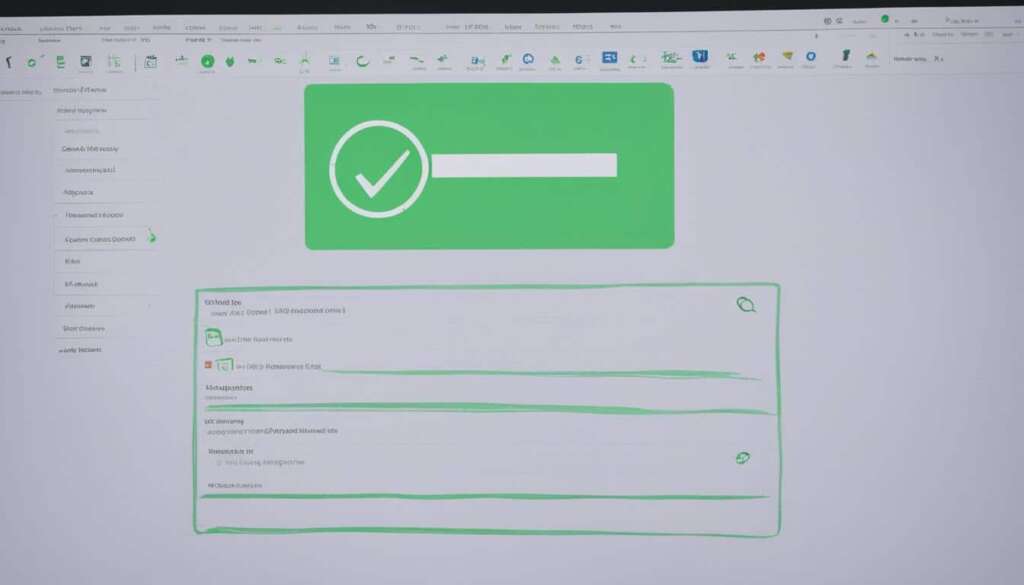Table of Contents
Smoke testing, also known as build verification testing or confidence testing, is a software testing method used to determine if a new software build is ready for the next testing phase. It focuses on testing the most crucial functions of the program to identify any basic and critical issues before proceeding with further testing.
Smoke testing plays a pivotal role in enhancing software stability and functionality during the early stages of development. The goal of smoke testing is to discover simple but severe failures using a minimal set of tests that cover the most important functionalities of the software. Without smoke testing, major issues may slip through the cracks and cause larger problems down the line.
What is Smoke Testing?
Smoke testing, also known as build verification testing or confidence testing, is a software testing method used to determine if a new software build is ready for the next testing phase. It serves as a preliminary check of the software, focusing on testing the most important functionalities, rather than delving into finer details. The goal of smoke testing is to find basic and critical issues before proceeding with more in-depth testing.
If a software build passes the smoke test, it indicates that it can move forward to further testing by the quality assurance (QA) teams. However, if it fails the smoke test, the software must be handed back to the development team for necessary fixes and improvements.
Smoke testing plays a crucial role in ensuring the quality and functionality of the software early in the development process. By identifying any major flaws or defects, it helps prevent them from causing larger problems in the subsequent phases of testing and development.
Smoke testing serves as a preliminary step to catch basic and critical issues before further testing is conducted.
During the smoke testing process, the most important functionalities of the software are tested to gain confidence in its overall functionality. This approach allows for a quick assessment of the software’s readiness for further testing and prevents wasting time on finer details that can be addressed later on.
Benefits of Smoke Testing:
- Early detection of major issues and defects
- Improved software stability and functionality
- Saves time and resources in the testing process
- Enhanced confidence in the software build
Performing a Smoke Test:
To perform a smoke test, the QA team follows these steps:
- Prepare a set of predefined test cases that cover the most critical functionalities of the software.
- Execute the smoke test by running the predefined test cases.
- Analyze the results and determine if the software passes or fails the smoke test.
- If the software passes, it can proceed to the next testing phase. If it fails, it should be sent back to the development team for necessary fixes.
Overall, smoke testing is an essential part of the software development process. It provides a preliminary check of the software’s functionality and identifies any major issues, allowing for timely fixes and improvements. By focusing on the most important functionalities, smoke testing ensures the overall quality and stability of the software build.
Types of Smoke Testing
When it comes to smoke testing in software development, there are various types that can be utilized based on the specific requirements of the development process. These include manual smoke testing, automated smoke testing, and hybrid smoke testing.
Manual Smoke Testing
Manual smoke testing involves human software testers who manually create and update test cases. This method allows testers to have more control over the testing process and adapt to any changes or updates in the software. Manual smoke testing requires careful analysis and execution, ensuring that critical functionalities are thoroughly evaluated for any issues or flaws.
Automated Smoke Testing
Automated smoke testing utilizes software tools to automate the testing process. With the help of automation, relevant smoke tests are automatically executed, making the testing procedure more efficient and less time-consuming. This approach is particularly useful for larger projects where repetitive testing is required, as it saves valuable time and resources.
Hybrid Smoke Testing
Hybrid smoke testing combines both manual and automated testing approaches. In this method, software testers initially develop manual test cases, ensuring comprehensive coverage of critical functionalities. These manual tests are later automated using tools, allowing for faster and more efficient execution. Hybrid smoke testing strikes a balance between the advantages of manual and automated testing, leveraging the strengths of both approaches.
The choice of the type of smoke testing depends on factors such as the complexity of the software, available resources, and the specific needs of the development process. Each type of smoke testing has its own benefits and considerations, and understanding these variations is essential for implementing an effective testing strategy.

| Types of Smoke Testing | Methodology | Advantages |
|---|---|---|
| Manual Smoke Testing | Human testers manually develop and update test cases. |
|
| Automated Smoke Testing | Software tools automate the testing process. |
|
| Hybrid Smoke Testing | Combination of manual and automated testing approaches. |
|
How Smoke Testing Works and How to Perform a Smoke Test
Smoke testing is a crucial step in the software development process performed by quality assurance (QA) testers. It involves verifying the stability and functionality of a new build delivered by the developers. This process ensures that the build is ready for integration with existing systems and further testing.
There are two main approaches to performing smoke tests: manual and automated testing. Manual smoke tests are executed by human testers who carefully follow predetermined test scenarios to identify any critical flaws. On the other hand, automated smoke tests employ previously written scripts to run a set of predefined tests automatically. This method is especially beneficial for larger and more complex projects as it saves time and allows for thorough testing.
Another approach to smoke testing is a hybrid method that combines manual and automated testing. Tester write the test scenarios manually and then automate them using specialized tools. This hybrid approach takes advantage of the benefits of both manual and automated testing and allows for more flexibility in the testing process.
The smoke testing process involves several steps:
- Deciding on the type of testing: Determine whether manual, automated, or a hybrid approach is the most suitable for the project.
- Creating testing scenarios and test suites: Define specific scenarios and test suites that will be used to evaluate the software’s functionality and stability.
- Running and recording tests: Execute the smoke tests according to the defined scenarios and record the results for analysis.
- Analysing the results: Evaluate the test results to identify any critical flaws or issues that need to be addressed before proceeding with further testing.
By following the smoke testing process, software development teams can catch major flaws early on, allowing for prompt bug fixes and preventing the propagation of issues throughout the development cycle.
“Smoke testing allows software development teams to identify critical flaws before proceeding with further testing.”
Performing smoke tests not only helps ensure the stability and functionality of the software but also minimizes the risk of encountering major issues during subsequent testing phases. It serves as a valuable quality assurance measure that saves time, effort, and resources in the long run.
The Importance of Smoke Testing in the Software Development Lifecycle
Smoke testing holds a significant place in the software development lifecycle due to its ability to uncover critical bugs and flaws before they become more complex and costly to fix. Performing smoke tests early ensures that the software build is stable, reliable, and ready for further integration and testing. It is an essential step in the journey towards delivering high-quality software that meets user expectations and requirements.
Advantages of Smoke Testing
Smoke testing plays a crucial role in the software development process, offering several notable advantages.
“Smoke testing enables faster and more frequent testing through automation.”
Automation is a key advantage of smoke testing. By automating the testing process, software teams can save time and resources. Automated smoke tests can be executed quickly and efficiently, allowing for faster feedback and identification of issues. This accelerates the overall development process and helps ensure that software releases are delivered on time.
“Smoke testing helps improve software stability by ensuring that builds are bug-free.”
Another significant advantage of smoke testing is its contribution to software stability. By conducting rigorous testing on the most critical functionalities of the software, smoke testing helps identify and eliminate potential bugs early on. This proactive approach reduces the risk of introducing stability issues in subsequent testing phases or after deployment. With fewer bugs, the software will be more reliable, providing a better user experience.
“Early defect detection reduces risks associated with code integration.”
Early defect detection is another advantage of smoke testing. By identifying and addressing defects in the early stages of development, the risks associated with code integration are significantly reduced. This allows software teams to address issues before they become more complex and costly to fix. Early defect detection helps ensure that the software meets the required quality standards and minimizes the likelihood of critical failures.
“Smoke tests can be easily run often, thanks to their low resource requirements and simple process.”
Smoke testing offers flexibility in terms of implementation. It can be performed manually, through automated testing, or using a hybrid approach. The simplicity of smoke testing allows for frequent execution, minimizing the time and resources required for testing. This agility enables software teams to quickly identify and address any potential issues, ensuring the stability of the build as early as possible.
“Overall, smoke testing verifies software quality early on, reducing risks and ensuring software stability.”
Summing up, smoke testing provides numerous advantages in the software development process. Through automation, it enables faster and more frequent testing, improving overall efficiency. By ensuring bug-free software, it enhances stability, while early defect detection reduces risks associated with code integration. With its low resource requirements and simple process, smoke testing allows for easy and frequent execution. Ultimately, smoke testing verifies software quality early on, ensuring the stability of the build and enhancing the overall software development process.
Disadvantages of Smoke Testing
While smoke testing offers many advantages, it is important to consider its limitations. One key disadvantage is the limited functionality coverage provided by smoke testing. This testing method focuses solely on the core functionalities of the software, neglecting other areas that may contain bugs or problems. As a result, not every issue may be detected during smoke testing, leading to potential issues surfacing later in the development process.
Another drawback of smoke testing is the potential for late bug detection. Since smoke testing is performed early in the testing phase, it may not uncover all bugs or defects within the software. Some issues may only be discovered during subsequent testing stages, causing delays in bug resolution and potentially impacting project timelines.
Furthermore, manual smoke testing can be time-consuming, especially for larger projects with a significant number of tests. In this approach, testers manually execute the tests, which requires considerable time and resources. The manual nature of smoke testing can slow down the overall testing process and increase the time required for bug identification and resolution.
It is crucial to carefully evaluate the benefits and drawbacks of smoke testing when determining the most effective approach for a specific software development process. By weighing the advantages and disadvantages, developers and testers can make informed decisions to ensure comprehensive testing and deliver high-quality software.
Smoke Testing vs. Regression Testing vs. Sanity Testing
Smoke testing, regression testing, and sanity testing are three different software testing methods used to ensure the stability and functionality of an application. Smoke testing focuses on testing the most crucial functions of the software, providing an early detection mechanism for severe defects. It is performed early in the development process to catch major issues before escalating to further testing phases. By contrast, regression testing aims to identify potential bugs or issues introduced through code changes, ensuring that the application continues to function correctly even after modifications have been made. Sanity testing, on the other hand, verifies the reliability of the application by quickly checking if the critical functionalities are working after bug fixes or minor changes.
Smoke testing serves as a preliminary check, while regression testing and sanity testing can be conducted throughout the testing lifecycle. Each method has its own objectives and depth of testing. Smoke testing offers a quick and simple assessment of basic functionalities, providing an initial understanding of the software’s stability. Regression testing delves deeper, examining the impact of changes on the overall system, ensuring that the application remains defect-free. Meanwhile, sanity testing focuses on verifying the specific areas affected by changes.
These software testing methods can be implemented manually or through automation, depending on the complexity of the application and available resources. Understanding the differences between smoke testing, regression testing, and sanity testing is crucial for choosing the appropriate approach and ensuring software stability. By employing these testing methods, developers and quality assurance teams can effectively detect defects, maintain functionality, and deliver high-quality software to end-users.
FAQ
What is smoke testing?
Smoke testing, also known as build verification testing or confidence testing, is a software testing method used to determine if a new software build is ready for the next testing phase. It focuses on testing the most crucial functions of the program to identify any basic and critical issues before proceeding with further testing.
What are the types of smoke testing?
There are different types of smoke testing that can be employed based on the needs of the software development process. Manual smoke testing is conducted by human software testers who manually develop and update test cases. Automated smoke testing uses software tools to automate the testing process, making it more efficient. Hybrid smoke testing is a combination of manual and automated smoke testing.
How does smoke testing work and how to perform a smoke test?
Smoke testing is performed by quality assurance (QA) testers after the developers deliver a new build of an application. It can be done manually or through automated processes using previously written scripts. The specific process for performing a smoke test may vary, but typically involves deciding on manual, automated, or hybrid testing, creating testing scenarios and test suites, running and recording tests, and analyzing the results.
What are the advantages of smoke testing?
Smoke testing offers several advantages in the software development process. It enables faster and more frequent testing through automation. By ensuring that future builds are constructed on bug-free software, smoke testing helps improve software stability. It also helps detect defects in the early stages of development, reducing the risks associated with adding code to existing build integrations.
What are the disadvantages of smoke testing?
While smoke testing offers many advantages, there are also some disadvantages to consider. One limitation is that smoke testing doesn’t cover all functionalities of the software, only focusing on specified core functionalities. This means that not every bug or problem may be found during smoke testing, and some may still be discovered later in development. In addition, manual smoke testing can be time-consuming, especially for larger projects where many tests are involved.
How does smoke testing differ from regression testing and sanity testing?
Smoke testing, regression testing, and sanity testing are three different software testing methods used to ensure the stability and functionality of an application. While smoke testing focuses on testing the most crucial functions of the software, regression testing assesses if changes to the application introduce defects and sanity testing ensures the reliability of the application. Each testing method has its own objectives and depth of testing, and they can be implemented manually or through automation.













